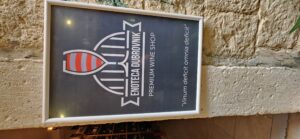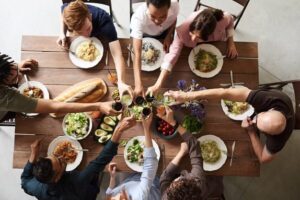Enotecas are a distinctly Italian combination of wine bar, wine store and snack bar. Like wine bars around the world, they’re places to relax, sip some wine, people watch and engage in a little conversation (much easier to talk with others, of course, if you speak Italian).
Some Italian enotecas are raffish and frequented primarily by locals. Others are in areas where they are sure to have tourists dropping by as well. Nibbi belongs in the latter category. It’s located just off the famed Via Veneto, the hillside roadway in Rome that has long been a byword for moneyed elegance. The area near Nibbi contains posh hotels, excellent restaurants and the American Embassy. So while the hoi polloi might find their way to Nibbi, you’re more likely to find a more refined crowd.
It’s not that you need to be rich to go there. There are about 20 wines to choose from, including reds and whites from around Italy, plus rosés and bubblies. Beer and aperitifs are also served. The pours are generous and the prices are amazingly inexpensive. Glasses of most of their wines run between six and nine euros. We’ve seen prices two to three times that cost back home.
The wines available by the glass are also available by the bottle, to be consumed on-site or taken home. The wines by the glass may not always be the greatest exemplars of their vintages, but they’re not plonk either. You can have a great tour of Italian vineyards without leaving your seat.
The food menu runs to potato chips, olives, salads, sandwiches and platters of slices salumi and cheeses. All seemed very appetizing as they were served to other parties. We always stopped at Nibbi for a pre-prandial glass or two before proceeding to the local restaurants, so we never tried their food.
The interior of the enoteca is quite nicely appointed, more like the American equivalent of a cocktail lounge than a bar.
But the place to sit is outside, especially in nice weather, which in Rome seems to have at least ten months a year. There’s always a crowd gathering in front of nearly all enotecas, but Nibbi also offers a glassed “shed” where there always seems som ething going on. We’ve seen large parties, with bottles and platters seeming to arrive every ten minutes. There was a fellow on his PC writing what must have been the Great Italian Novel, made up of equal parts of inspiration, wine and cigarettes. And there was a woman enjoying a glass of wine by herself without getting hassled (try that in New York!).
ething going on. We’ve seen large parties, with bottles and platters seeming to arrive every ten minutes. There was a fellow on his PC writing what must have been the Great Italian Novel, made up of equal parts of inspiration, wine and cigarettes. And there was a woman enjoying a glass of wine by herself without getting hassled (try that in New York!).
The complete name of this enoteca is Bar Enoteca Nibbi dal 1936, meaning that actual fascists and their followers must have drunk there back in the early days. As with almost everywhere in contemporary Europe, it’s hard – at least for visitors – to conceptualize the destruction and despair of war in these lovely sites. So, we recommend, don’t do more than give momentary thought to the past, drink up and live for today and tomorrow. Nibbi certainly provides a pleasant venue for such enjoyment.
















